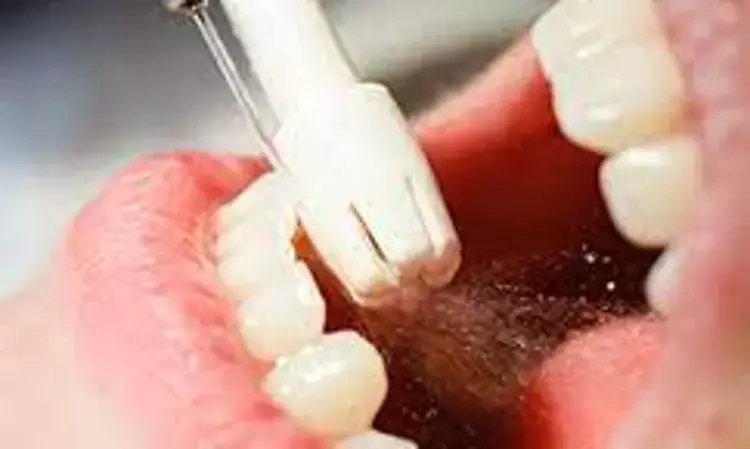- Home
- Medical news & Guidelines
- Anesthesiology
- Cardiology and CTVS
- Critical Care
- Dentistry
- Dermatology
- Diabetes and Endocrinology
- ENT
- Gastroenterology
- Medicine
- Nephrology
- Neurology
- Obstretics-Gynaecology
- Oncology
- Ophthalmology
- Orthopaedics
- Pediatrics-Neonatology
- Psychiatry
- Pulmonology
- Radiology
- Surgery
- Urology
- Laboratory Medicine
- Diet
- Nursing
- Paramedical
- Physiotherapy
- Health news
- Fact Check
- Bone Health Fact Check
- Brain Health Fact Check
- Cancer Related Fact Check
- Child Care Fact Check
- Dental and oral health fact check
- Diabetes and metabolic health fact check
- Diet and Nutrition Fact Check
- Eye and ENT Care Fact Check
- Fitness fact check
- Gut health fact check
- Heart health fact check
- Kidney health fact check
- Medical education fact check
- Men's health fact check
- Respiratory fact check
- Skin and hair care fact check
- Vaccine and Immunization fact check
- Women's health fact check
- AYUSH
- State News
- Andaman and Nicobar Islands
- Andhra Pradesh
- Arunachal Pradesh
- Assam
- Bihar
- Chandigarh
- Chattisgarh
- Dadra and Nagar Haveli
- Daman and Diu
- Delhi
- Goa
- Gujarat
- Haryana
- Himachal Pradesh
- Jammu & Kashmir
- Jharkhand
- Karnataka
- Kerala
- Ladakh
- Lakshadweep
- Madhya Pradesh
- Maharashtra
- Manipur
- Meghalaya
- Mizoram
- Nagaland
- Odisha
- Puducherry
- Punjab
- Rajasthan
- Sikkim
- Tamil Nadu
- Telangana
- Tripura
- Uttar Pradesh
- Uttrakhand
- West Bengal
- Medical Education
- Industry
Extraoral scavenger devices may increase in-treatment safety in dentistry by reducing aerosols

Researchers have found in a new study that Extraoral scavenger devices for aerosol reduction increase in-treatment safety in the dental operatory.
The study published in the International Dental Journal.
Aerosol is generated during most dental procedures and patient interactions. As the COVID-19 pandemic, unfortunately, has reminded us, aerosol is a potent carrier of pathogenic microorganisms. Contamination from spatter and aerosol dissemination has been recognised as a significant hazard for dental personnel for about 30 years. Similarly, extraoral suction units have been long recognised as an efficient means of reducing the aerosol burden of the dental operatory. Teanpaisan et al demonstrated that a modified household vacuum cleaner can be effectively used for reducing aerosol dissemination into the airspace of the dental operatory. King et al concluded that aerosol concentration was substantially reduced 6 inches away from a patient when using an aerosol reduction device. However, until the onset of the COVID-19 pandemic, the topic had not generated much interest. Questions such as the particle size range in which such devices are effective or the comparative efficiency of the available models in specific dental interventions remained unanswered.
Since the outbreak of SARS-CoV-2, aerosol control in the operatory has become a key safety issue in dentistry. The utilisation of extraoral scavenger devices (EOSs) is one of the various approaches to in-treatment aerosol reduction in dentistry. The use and efficacy of EOSs in dental settings, however, are still a matter of debate in the literature and there are still open questions about their proper use. Thus, research into this area is essential to inform dental practice. The objective of this study was to examine the aerosol reduction efficacy of two different EOS in vitro.
Two commercially available EOSs were tested during modeled dental treatment in a setup that previously proved to generate high aerosol load. Measurements were done in two particle size ranges: 5.6–560 nm (the full range of the spectrometer) and 60.4–392.4 nm (a range that is especially relevant to the spread of SARS-CoV-2 with aerosol).
Results
Both devices managed to reduce the aerosol load to a statistically significant extent as compared to the scenario when only a high-volume evacuator and a saliva ejector (and no EOS) were used.
Thus, Within the limitations of the study, the results support the assumption that EOSs for aerosol reduction increase in-treatment safety in the dental operatory.
Reference:
Dorottya Gheorghita, Fruzsina Kun Szabó, Tibor Ajtai, Szabolcs Hodovány, Zoltán Bozóki, Gábor Braunitzer, Márk Ádám Antal. Aerosol Reduction of 2 Dental Extraoral Scavenger Devices In Vitro, International Dental Journal, Volume 72, Issue 5, 2022, Pages 691-697, ISSN 0020-6539, https://doi.org/10.1016/j.identj.2022.05.007
Dr. Shravani Dali has completed her BDS from Pravara institute of medical sciences, loni. Following which she extensively worked in the healthcare sector for 2+ years. She has been actively involved in writing blogs in field of health and wellness. Currently she is pursuing her Masters of public health-health administration from Tata institute of social sciences. She can be contacted at editorial@medicaldialogues.in.
Dr Kamal Kant Kohli-MBBS, DTCD- a chest specialist with more than 30 years of practice and a flair for writing clinical articles, Dr Kamal Kant Kohli joined Medical Dialogues as a Chief Editor of Medical News. Besides writing articles, as an editor, he proofreads and verifies all the medical content published on Medical Dialogues including those coming from journals, studies,medical conferences,guidelines etc. Email: drkohli@medicaldialogues.in. Contact no. 011-43720751


